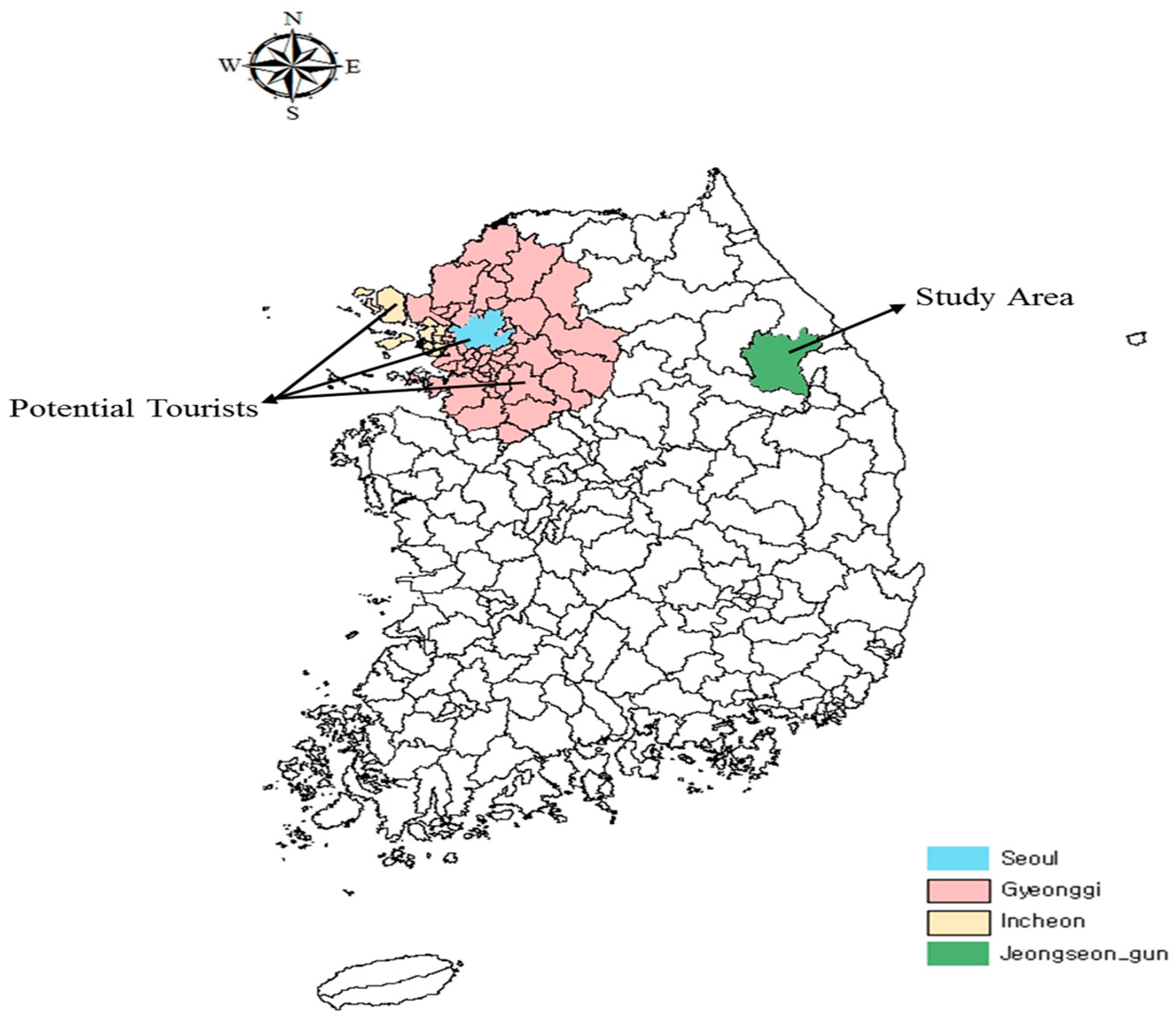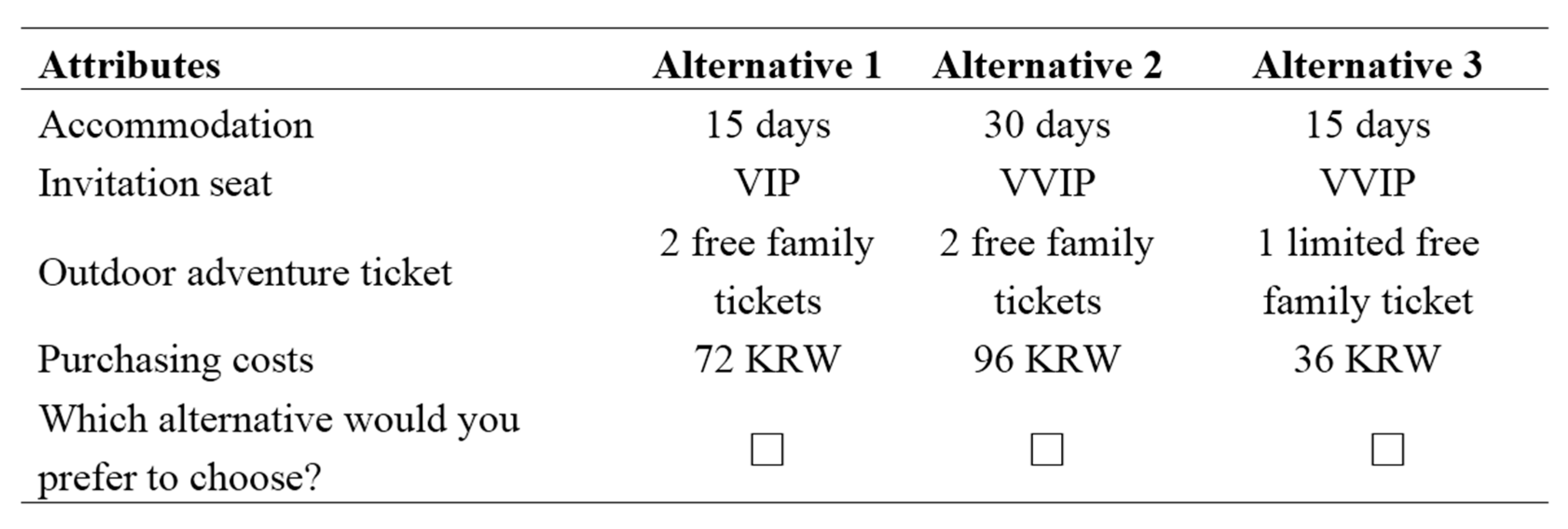3.2. Model Results
All econometric model parameter estimates were estimated using maximum likelihood estimation procedures using the econometric software STATA 10 (Note that all models were estimated without including alternative specific constants (ASC) since the alternatives presented to the respondents are all generic alternatives). The results are summarized in
Table 4.
CNL is the base conditional logit model without incorporating respondents’ heterogeneity. ICNL and RCNL represent the conditional logit models which incorporate income and residence effects into the model, respectively.
In the base CNL model, all parameters except
accom variable are statistically significant and follow the expected signs. The
price variable is negative, implying that an increase in prices has a negative impact on respondents’ choice. The positive sign of parameters for
seat and
play variables indicates that respondents are sensitive to the increase in the level of these variables. The
accom variable is statistically insignificant, implying respondents are insensitive to the number of days of accommodation use when making a choice. This is probably due to the fact that as shown in
Table 2, the sample respondents prefer to short-term trips (i.e., the length of stay per trip is only 3 days). In addition, according to Cho et al. [
26] and Rural Resource Development Institute [
27], Korean rural tourists do not in general intend to stay for a long duration in the rural tourism experience. This variable, however, appears to be significant for the respondents in the other model, who have a longer travel distance and time and thus longer expected length of stay.
Parameter estimates in the ICNL also follow expected signs. The interaction terms, low × price, mid × price, and high × price represent the marginal utility of income for each income level. The coefficients on these variables are negative and highly significant and the implied marginal utility of income decreases as income increases, which is consistent with the general assumption of decreasing marginal utility of income. While mid × seat is statistically insignificant, low × seat and high × seat are positive and significant implying that low and high income households are sensitive to invitation seat. The coefficients on the variables, low × play, mid × play, and high × play are all positive, implying that an increase in the level of outdoor adventure tickets has a positive impact on choice.
Similar to the results of ICNL model, the parameters of seoul × price, gyeonggi × price, and incheon × price are all negative and significant in the RCNL model. These three significant parameters suggest that price increases have a negative influence on choices. All accommodation-related variables are statistically insignificant in the CNL and ICNL model, and incheon × accom is positive and significant at the l0% level, implying that respondents living in Incheon area are sensitive to the number of days of accommodation use in rural tourism. This is probably due to the fact that, because of longer travel distance, Incheon residents require more time to travel to Jeongseon_gun than Seoul and Gyeonggi residents. To validate this, we conducted statistical tests in which the null hypothesis is the mean difference of expected days of stay between Incheon and other two residents. The results indicated that the expected days of stay in Jeongseon_gun between two groups are statistically different. However, an increase in the level of invitation seats has no impact on choice for Incheon residents. As is in the ICNL model, an improvement in the level of outdoor adventure tickets has a positive impact on choice for all respondents.
Based on the parameter estimates presented in
Table 4, we calculated that the MWTPs for each attribute were statistically significant using Equation (3). The calculated MWTPs can be interpreted as the increase in purchasing costs of agricultural products in return for increase in one level of each attribute. The results are summarized in
Table 5. Based on CNL model, MWTPs for
seat and
play variables are about US
$68 and US
$119, respectively. Incheon residents are only willing to pay about US
$12 for one day increase in accommodation use in RCNL model. Based on ICNL model MWTPs for
seat variable are about US
$116 and US
$80 for low and high income households, respectively. Using the RCNL model they are about US
$53 and US
$76 for Seoul and Gyeonggi residents. With respect to MWTPs for the
play variable, they are about US
$130, US
$87, and US
$162 for low, middle, and high income households, respectively. Using the RCNL model they are about US
$96 for Seoul residents, US
$135 for Gyeonggi residents, and US
$188 for Incheon residents. Given the comparison of MWTPs for each attribute calculated from all three models, the largest MWTPs are placed on outdoor adventure tickets.
3.3. Application of the Model
To examine the economic impact associated with promoting higher-level membership, we calculate the utility levels for each level of membership using the parameter estimates in
Table 4 and the corresponding attribute levels are presented in
Table 6.
Table 7 presents the results of the economic impact associated with the difference between low- and middle-level and between low- and high-level Jeongseon Sarang Membership from each model. The total impacts presented in the 5th to 10th columns of
Table 7 were calculated assuming 5%, and 10% of actual number of households (885,420 households in total) who visited Jeongseon_gun for rural tourism in 2015 provided by Jeongseon County join Jeongseon Sarang Membership. In the ICNL model, we assumed that the proportions of each income category make up 33.33% of total households each because no information regarding the number of households per income category is available. Similarly, we assumed that each residence category corresponds to 33.33% of total households in the RCNL model.
The economic impacts per household per year calculated from the CNL model are about US $187 for and US $374 for . These amounts illustrate annual willingness to pay (WTP) per household, which can be interpreted as increase in the annual purchasing costs of agricultural products produced in Jeongseon_gun as a result of increase in the level of Jeongseon Sarang Membership (i.e., more benefits resulting from increase in membership levels). Assuming 5% and 10% of households join the Jeongseon Sarang Membership, total economic impacts for are US $8.3 million and US $16.6 million while for − they are US $16.6 million and US $33.1 million, respectively. Other results using the ICNL and RCNL models can be interpreted in a similar way to that which is applied to the CNL model case. The calculated economic impacts that the promotion of higher-level Jeongseon Sarang Membership can generate are considerable and these estimates illustrate the substantial impact of revitalizing rural tourism membership on boosting the local economy.
3.4. Discussion
In this section, we compare the estimated economic impact of rural tourism membership on sales of agricultural products to Gross Regional Domestic Products (GRDP) in agriculture, forestry, and fishery in Jeongseon_gun in 2015 provided by Statistics Korea [
28] to examine whether the demand exceeds the supply or not. Depending on model specifications, the estimated economic impacts of the rural tourism membership cover 14.3–33.9% of the GRDP produced in Jeongseon_gun (
Table 8). This illustrates that the introduction of rural tourism membership can aid in maintaining the sustainability of rural economy by ensuring the continued sales of agricultural products produced in the rural areas. In other words, a partnership between loyal tourists and tourist attractions such as rural tourism membership could be a good strategy to revitalize the rural economy via an increase in farmers’ income.
In an attempt to examine the consistency of our results, we compare our findings with other studies that explore the economic impact of rural tourism on rural development using different modelling approaches. Giannakis [
2] found empirical evidence that rural tourism can establish strong relationships with food manufacture and agriculture and generate synergies to create sustainable development in the long run. Muresan et al. [
1] found that rural tourism development has the potential to improve the wellbeing of local communities thanks to its positive effect on income generation. This implies that our findings are in line with similar studies in tourism literature.








